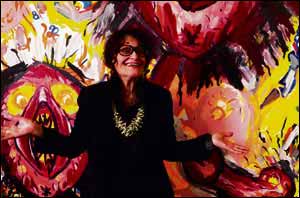|
PROFILE Judith made sure women artists were in the frame | |
SEPTUAGENARIAN artist Judith Bernstein has been painting for more than 50 years... yet she has only achieved fame in the last five.
The story of Judith's delayed success mirrors that of women's emancipation in the USA. Born to second-generation immigrant Jewish parents who spoke Yiddish when they didn't want their daughter to know what they were saying, Judith was studying at Yale University during the anti-Vietnam war protests, in which she got caught up. The raging anti-establishmentarianism of that time has never left Judith and is still at the forefront of her current artwork, which will be on display at London's Studio Voltaire from July 5-August 24. Interested in art from an early age, Judith's early work in high school and undergraduate school included Judaica such as menorot, Torah scrolls and Hebrew calligraphy. But, she said: "My work has taken a big turn away from that." Yale University in the 1960s was incredibly sexist. She said: "When I went to Yale as a graduate, the undergraduates were all male." On her first day at the university, she was told that because she was a woman she would get no work as an artist. And in fact, for more than 40 years, Judith. who now has prestigious exhibitions all over the world, had to teach and lecture in order to make a living. The sex discrimination fuelled Judith's anti-Vietnam rage and she began producing works of art which equated male sexuality with the violence of war. Together with other ostracised women artists she formed Artists in Residence, which exhibited only women's work. She said: "When I graduated from Yale in the 1970s there were a lot of women who had gone to undergraduate programmes and they didn't have anywhere to show. They couldn't exhibit. "Women were not supposed to have studios. I got together with a group of artists and we opened the first women's gallery that showed women artists in 1972." Then, two years later, Judith's work was banned from an exhibition of feminist art in Philadelphia because it was too sexually explicit. It took more than 40 years for it to become all the rage. So where does all the rage come from? "I think my aggressiveness is very similar to the immigrant mentality," said Judith, a member of Guerrilla Girls, who style themselves as "feminist masked avengers" fighting censorship against women in the art world. "My mother had a lot of anger. I used that anger in terms of women in art who didn't have the venues to be themselves." But while most feminists have moved on and become part of the mainstream, Judith's current work still hangs onto the original rage which fuelled many early feminists. At Studio Voltaire, she is currently working on a massive painting entitled Birth of the Universe. She said: "I'm making an analogy between the universe which is constantly expanding and the information we are getting which is expanding and the male and the female and the connection between both. "Everything is interconnected. The painting mirrors a lot of the dialogue that is happening today. Women are getting much more powerful." But like her earlier banned work, her current work is still full of explicit imagery. But Judith said: "It's not a sexual turn-on. It's a political statement. Women are the source of the universe. Men are intimidated by that." She admitted: "The work which I am doing is very edgy and speaks of the zeitgeist of the 1960s and 70s. I am dealing with male anger and machoism, asserting that the female is the centre of the universe and the birth. "I'm very explosive. I always had a very raucous sense of humour. I was always outrageous. When you do things which are most explosive, you call attention to the issues that you are interested in. Without screaming, people don't hear what you have to say." Judith feels that political screaming works. Thanks to the 'guerrilla' tactics employed by her and her fellow women artists, women now play a much more prominent part in the art world. She said: "Galleries feel they want to be politically correct because they are on the left. "We specifically named galleries which had fewer than 10 per cent women, critics who reviewed fewer than 10 per cent of women and museums that had shows with fewer than 10 per cent of women." Judith added: "Today people are much more open to work which deals with sexuality. Also my work has a great deal of humour and a lot of fun. "I get my wonderful humour from my background and it is the right time for my work. "Being a bad girl has its perks. It is more fun. It is keeping me young, in tune with my passion and what I want to say."
|
